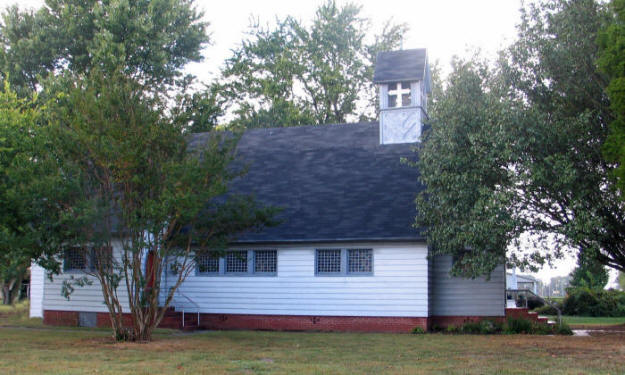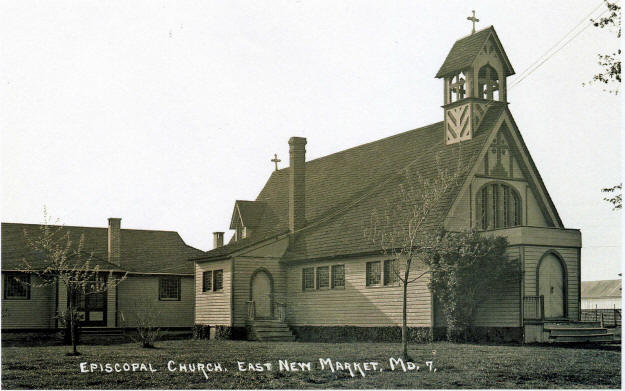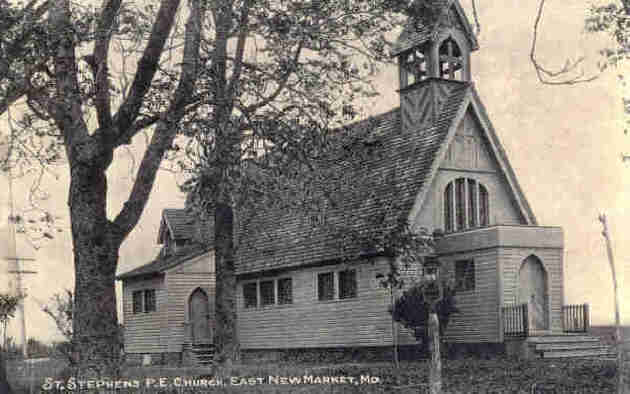East New Market
Property Reports
116 Main Street
St. Stephens Episcopal Church (1893)

The Vestry of East New Market Parish purchased three adjacent tracts of land at this site. The first tract was purchased in 1892. It is now the centermost tract and the site of St. Stephens Episcopal Church. The larger southernmost tract was purchased in 1894. It was the site of the Female Seminary and is now the site of the St. Stephens Parish Hall. A smaller thin tract just north of the Church was purchased in 189?.
Reverend Frederick W. Wey is credited with directing the construction of the church building in 1893. He did a tremendous amount of work on the exterior and interior with his own hands.

As seen in the 1916 postcard photo above, the parish hall was originally closer to the church than it is today.
St. Stephen's Church, East New Market Parish, 1805-1965, by Rev. William L. English
The Rev. James Kemp, who became the second Bishop o Maryland in 1816, was a rector of Great Choptank Parish and apparently had a tremendous interest in his parish church and the other congregations. In the Maryland convention records of his day, we find that in 1805 a chapel was built in New Market for the purpose of Anglican worship. This was the first church in what is now East New Market.
By 1820, according to the records, the War of 1812, as the Revolution before, had grave effects on the Anglican Church in Maryland. It also seems Presbyterians were causing problems on the Eastern Shore, and the little chapels in New Market and Vienna were in "deplorable condition".
The Maryland Convention of 1839 met in old St. Paul's Church, Baltimore, and in the parochial reports of that date we can find one from the Rev. Enoch Bayley, first rector of New Market Parish. It further states that a cornerstone had been laid for the new church then under construction. This apparently was the church that stood on the grounds of the present East New Market School.
The first convention of Diocese of Easton met in 1868 and included in the list of parishes and among the parochial reports was East New Market Parish. The parish apparently was small, but the few communicants were faithful and devoted people of God.
In 1884 a Rectory was purchased for the priest by the ladies of the Parish. This we believe was very near the Church and may be the house still standing next to the public school in East New Market.
By 1889 the rector, the Rev. James W. Keeble, reported that a horse had been purchased for him, but the Church building was in sad condition and was about to be condemned. However, he further stated that an effort was being made to obtain a better lot and build a new Church. This new Church is obviously the one we worship in today. The Parochial Report of 1891, by Fr. Keeble, reads: Our Church Building has been condemned. We worship at present in an old School House adjoining the Rectory. My work has been most unsatisfactory to myself, and insufficient by reason of ill health, and for the lack of a Church building and a conveyance for visiting.
Financial problems besieged the Parish in the early 1890's, but things began to look brighter by 1892 when the Rev. Frederick W. Wey came to assume the responsibilities as priest of the Parish. In his parochial report of 1892 he wrote: While this parish is in a rather poor condition, having lost its rectory for want of money to pay the mortgage, and the Church building having had to be torn down on account of its unsafe condition, yet during my short rectorate dating only from January 1892, fresh interest has been awakened. The old Seminary building has been renovated, and the interior presents quite a churchly appearance.
Fr. Wey is due special praise for his work in the Parish. He directed the construction of the present Church building, and did a tremendous amount of work on the exterior and interior with his own hands. The cornerstone was laid in 1893.
Through the act of the last Assembly, the parish has also come into the possession of the property of the "East New Market Female Seminary" adjoining the Church property, containing a lot 75 x 156 feet and the old school-house, which will be a great convenience to the parish and enhance the value of the property materially. In 1897 and organ fund was established and the amount of $107 collected for an instrument suitable for the new Church.
St. Stephen's, like so many parish churches, has suffered her share through the years. There were times of prosperity, times of neglect, periods of poverty, and eras of silence and quiet, but through the troubles and the joys she has survived as a symbol of the faith through the generations. Today, the little grey frame church stands surrounded by handsome lawns and shaded by ancient maples. The interior presents an atmosphere and sense of reverence found only in the House of God where love exists not only in the things of God but between the brethren.

The postcard photo above was taken before 1909. The parish hall was built after this photo was taken.
From "Between The Nanticoke and the Choptank, An Architectural History of Dorchester County, Maryland" Edited by Christopher Weeks, with contributions by Michael O. Bourne, Geoffrey Henry, Catherine Moore, Calvin Mowbray, M. Fred Tidwell.
St. Stephan's is one of the finest of the rare examples of Romanesque Revival architecture in the county. It is a solidly built frame church painted gray. The stained glass windows on either side of the door are made up of small multicolored square panes. The interior is very striking and has been left virtually unchanged, even down to the wooden candlesticks on the side of each pew. To the rear of St. Stephen's is a small vestry, built at the same time and in a similar style to the church. This is the third Episcopal church in East New Market, although it is the first on this particular site. The earliest mention of a church in town was 1794, and a second one was built in 1805, although very little is known about either building.
From New Revised History of Dorchester County, Maryland by Elias Jones, Tidewater Publishers, Cambridge, Maryland - 1966, Chapter X, East New Market, by Miss Emma Edmondson Jacobs 1925
The Episcopal Church is the oldest [denomination] in the community, a structure decidedly picturesque, and reminiscent of the Old World cathedrals, has its sacred attractions.
From the Annual Candlelight Tour Brochure sponsored by the East New Market Heritage Foundation 1991
Third in a series of churches dating back to 1791 this beautiful house of faith's interior is an outstanding example of neo-Norman Architecture typical of the period, but rare in its fine execution on a small scale.
From the Maryland Historical Trust State Historic Sites Inventory Form
St. Stephen's P. E. Church stands on the west side of North Main
Street in the town of East New Market, Dorchester County, Maryland. The
Gothic Revival frame church faces east with the principal gable oriented
on an east/west axis. Accompanying the church is a single-story parish
hall that stands southwest of the church.
Built in 1893, the single-story Gothic Revival frame church is supported
by a continuous common bond brick foundation and sheathed with a uniform
layer of aluminum siding. The steeply pitched gable roof is covered with
asphalt shingles. Rising from the east gable end is a small gabled
belfry.
The east (main) facade of the main block is partially covered by a
single- story, one-bay frame entry that is marked by a Gothic arched
double-door entrance. Piercing the upper gable of the main block is a
four-part colored glass window. The uppermost portion of the gable is
distinguished by a cross, now covered by aluminum, which is part of a
patterned wood surface design. The eaves to the roof are slightly
extended. Fixed in the northeast corner of the foundation is the 1893
datestone. Also located in the northeast corner is an interior brick
stove stack which rises above the level of the roof. The small gabled
belfry has four arched openings, one on each side, with a white cross
fixed on each elevation. The base of the belfry is finished with a
decorative board pattern, and the gabled roof repeats the slope of the
church roof. A small cross rises from the top of the belfry.
The north side of the church is marked by four pairs of square colored
glass windows, and a gabled dormer is marks the roof above the
westernmost bay. The dormer, covered by a steeply pitched roof as
well, is lighted by a Gothic arched colored glass window. The south
side, on the other hand, is defined by two pair of colored glass windows
as well as a shed roofed sacristy that occupies the third bay from the
east. A narrow brick stove stack rises through church roof near the east
edge of the sacristy. The east side of the sacristy is pierced by a
Gothic arched door, and the south side is marked by pair of colored
glass windows. The west side of the church is a plain wall of horizontal
aluminum siding aside from a cross in the upper gable that has been
covered with aluminum as well.
The church interior has not been significantly changed since
construction in 1893. The sanctuary walls are covered by a combination
of beaded board wainscoting and plaster, while the ceiling is entirely
covered by a diagonal matched board sheathing. The scissors roof truss
is exposed. The altar area, by contrast, is entirely covered by diagonal
patterned beaded board, and the roof structure is concealed.
Distinguishing the raised altar is Victorian furniture. Opening
through the south wall is a shallow paneled door that provides access to
the sacristy, the interior of which is also covered with narrow beaded
boards. Fixed on the west wall are double-door vestment closets.
Significance - St. Stephen's P. E. Church stands as one of the most
unaltered of the Gothic Revival churches in Dorchester County. The
rectangular frame is distinguished by a gabled belfry as well as series
of square, colored glass windows that pierce each side. A patterned wood
sheathing incorporating a cross design marks the upper gable of the east
end. Inside, the late nineteenth-century church has not been altered and
rich honey-colored walls of patterned beaded board walls and ceilings
are complemented by period furniture and lighting. The scissors truss
roof system remains exposed and finished in a natural color that matches
the walls and ceiling. Standing southwest of the church is an equally
well preserved parish hall that was built during the early years of the
twentieth century.
An Index of the Source Records of Maryland, Genealogical,
Biographical
by Eleanor Phillips Passano 1940
St. Stephens' Parish 1836 - St. Stephens Church, East New Market; St. Andrews, Hurlock; Epiphany Mission, Preston. Register of births, marriages, and deaths prior to 1914 destroyed by fire. 1914-date in custody of Church.
Journal of the 26th Annual Convention of the Protestant Episcopal Church in the Diocese of Easton Held in Trinity Church Elkton June 5th and 6th 1894
East New Market Parish, East New Market - Rector - Rev. Benj. T.
Hall; Wardens - Isaac H. Wright and James Thomas M.D.; Vestrymen - Capt.
E.S. Johnson, Dr. James Thomas, Richard H. Stevens, Isaac H. Wright,
William Andrew, Fred. Wright, Dr. James Jacobs; Registrar Dr. James
Jacobs. Baptized members 78; families 15; souls 58, parishioners
78; baptisms of adults 1, of infants 2, total 3; confirmed 3;
communicants added 3, present number 85; Sunday School teachers 4,
pupils 25. Contributions - for Diocesan Uses, Conventional Fund
$20, Diocesan Missions $10, Total $30. For Parochial Uses -
Rector's salary, amount promised $280, so far paid in full; communion
alms (other than amounts reported under other headings) and other
charities for the poor $4.50. Church Property - One church,
sittings 120, value $3,600, insured for $2,000. Ladies have worked
faithfully and with constant energy, and have nearly paid debt on
church. They hope soon to see the debt extinguished and to have
the church ready for consecration.
Dates of Consecration and Re-Dedication - East New Market,
St. Stephen's (W.R.W.) 1850
The Rev. T.C. Page presented the following: A petition
to the Convention of the Diocese of Easton, meeting in Cambridge, Md. in
the month of June 1897, from the Vestry of East New Market Parish in
regard to the Parochial Assessments: In view of the fact that the
amount at which this parish is at present assessed was fixed when the
parish was more prosperous than now, and in view of the fact that the
parish is now in a somewhat depressed condition, owing to deaths and
removals, and because of the financial depression of the times:
We, the Vestry of the East New Market Parish, do hereby respectfully
petition the Convention of the Diocese of Easton that the amount at
which our parish is assessed for Convention expenses be reduced from $20
to $10. This will make a reduction in out Parochial Assessments
from $35 to $25. J.H. Thomas, Wm H. Andrew, E.S. Johnson, Wm. P.
Beckwith, Isaac H. Wright, Fred. Wright. On motion, the Petition
was referred to the Committee on Parochial Assessments.
East New Market Parish, East New Market - Wardens - Isaac H.
Wright; Vestrymen - Dr. J. H. Thomas, E.S. Johnson, I.H. Wright, Fred.
Wright, Wm H. Andrew, E.L. Hooper; Registrar Wm. P. Beckwith.
Baptized members 72; families 28; parishioners 78; baptisms infants 4,
total 4; marriages 1; burials 4; communicants died 4, present number 46;
Sunday School 1 officer, 4 teachers, 30 pupils. Receipts and
Contributions - for Diocesan Uses, Conventional Fund $20, Diocesan
Missions $15, Total $35. For Parochial Uses - Rector's salary,
amount promised $200, current expenses $10, Total $210. All other
purposes - Sunday School Library $15; Offerings for S.S. $15; Easter
offering $12.60; Ladies Guild $24; Organ Fund $107; Total $188.60.
Grand Total $418.60. Church Property - St. Stephen's church,
sittings 120, value $3,000, insured for $1,500. We have been
without a Rector since June 1895. During the interval we have
called several clergymen suited to the work, but unfortunately they have
rejected our invitation. Our church is ready for consecration.
The Parish Society deserves much credit for their continuance in good
works under very trying and discouraging conditions and circumstances,
for during the year they have gathered an Organ Fund of $107 in addition
to a reserve fund for necessary expenses. The Sunday School has
very much increased and improved, and under the care of a judicious
Rector would far surpass our fondest expectations. Now is the
opportunity for the P.M. Church to make her influence felt in this
field; the time is ripe, and with a suitable Rector who will undertake
the work, (of course ?ary is small,) success, we think, will follow his
efforts and labors. Wm. P. Beckwith, Registrar
Journal of the Proceedings of the Bishops, Clergy, and Laity of the Protestant Episcopal Church in the United State of American in A General Convention, held in the City of Philadelphia, from September 5, to September 17, Inclusive, A.D. 1838.
1838 - The Rev. Thomas Bayne, Rector of Dorchester Parish, Dorchester
County.
1841 - The Rev. Enoch Bayley, Rector of East New Market Parish,
Dorchester County.
1844 - The Rev. Enoch Bayley, Rector of East New Market Parish,
Dorchester County.